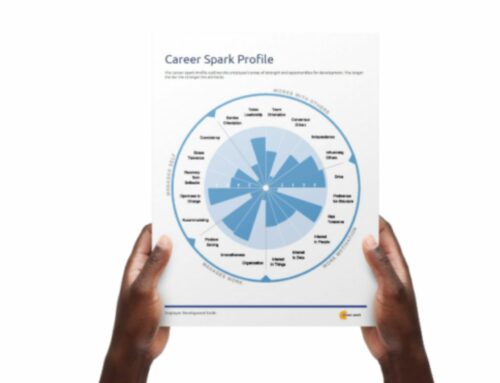The Biggest Employee Development Mistakes

Here’s a little story about a manager named Amy.
She’s a new marketing director for a large tech company with the critical job of supporting her employees’ training and development while also keeping an eye out for team members with leadership potential.
A few weeks into the role, she notices that one of her team members, Naima, is clearly outshining the rest. She decides to work more closely with her, to help prepare her for a more senior-level role. She invests a lot of time and energy, giving her stretch assignments and connecting her to learning and development opportunities before eventually promoting her.
Everything seems like it’s going according to plan. That is until Naima’s performance starts lagging dramatically. She’s disengaged, not meeting deadlines, and pretty soon, Amy’s left wondering if he made the right decision.
Where did Amy go wrong? It’s a common mistake that we see so many managers and people leaders make all the time. Employers tend to look at an employee’s past performance and use that as the sole metric for what they can and should do in the future.
“This employee is SO good at their job. That must mean they’d make a good manager, right?”
Wrong.
Employees with the best numbers or the most potential don’t always make the best leaders, and this line of thinking can lead to some major headaches down the line.
In this article, we’ll break down why this approach misses the mark and how employers can avoid making this employee development mistake in their organizations.
Problem #1: Overlooking skills gaps
Developing employees based on their technical competence or potential alone is like hiring a candidate based solely on their resume. There are a lot of factors that you should consider first. For example, interpersonal skills like communication, time management, relationship building, and delegation are often more critical to a leadership role than technical skills.
Solution: Create individualized employee development programs
So let’s go back to Amy and Naima. Before she invested in developing Naima, Amy should have set aside more time to evaluate her overall growth potential. For example, she could’ve worked with Naima one-on-one to review her job knowledge and people skills or given her access to a career pathing tool where she could evaluate herself. Based on the results of those assessments, Amy would then have a better idea of whether Naima was ready to be developed or if some critical skills gaps needed to be addressed first.
Problem #2: Not seeing the bigger picture
Many employers approach development opportunities as merely something they ‘should’ offer to keep their employees happy or to give them room to grow, rather than thinking about how it could benefit the company as a whole. What strengths or skills are missing from your current team, and what positions do you need to fill? The answers to these questions should directly influence who you choose to develop and how.
Solution: Connect development goals to business goals
Before you start developing your employees or even create an employee development plan, take a second to consider your department’s and your company’s long and short-term objectives. For example, in Amy’s case, if Amy’s marketing department was leading a large company rebrand project, he might actually need a project manager more than another marketing manager.
Once you’ve outlined your objectives, you can pin down the skills, knowledge, and competencies you’ll need from your team to support those goals. Then, you can use that information to decide how you will fill those gaps, whether that’s through employee development, hiring more talent, or outsourcing the work to a vendor.
Problem #3: Not considering employee’s goals and aspirations
A major employee development mistake is to assume that you know your employees’ potential or career aspirations. Not every employee wants to – or should – move into management, no matter how good they are in their current role. If this is the case, then the question employers need to answer isn’t “What kind of training should we offer this employee?” but “Should we be investing in their development at all or at this time?”
There’s also a difference between potential and readiness. For example, maybe Naima was interested in moving into the management role Amy saw for her but just had a baby and isn’t ready to take on more responsibility right now. Or perhaps she just needs more time to master a particular skill or software required for the role. Or maybe she’s just happy to stay put and isn’t interested in working her way up the career ladder. If your employee’s needs and goals don’t align with your own or your organization’s, no amount of staff training or development can fix this.
Solution: Work with your employees to create a career path
You can spend hours researching training opportunities or providing one-on-one coaching. Still, if your employee ultimately doesn’t want to be developed or isn’t ready for it, it’ll be a waste of time and energy.
One of the first things you should do is connect with each team member to understand their career goals and get a sense of their overall interest or readiness for development. Do they see themselves growing within the company? Are they happy in their current position? Are they struggling with any critical aspects of the work?
Keep in mind that some of your employees might not know what they want or what their next steps should be. In this case, giving your team access to an employee development tool can help you both gain the critical insights required to see if additional training, mentorship, or a stretch assignment would be beneficial.
Sometimes, the answer isn’t as simple as ‘I don’t want training’ or ‘I’m not interested in a management role.’ Your employee might have development goals but doesn’t know how to get started or if the company would support them. Or maybe they just need a little encouragement or acknowledgment that you see potential in them. Whatever the case may be, you won’t know until you talk to them directly. Once you have a better understanding of where they’re at, you can work together to figure out what role your business can play in their plans and what opportunities you can offer them.
Final Words
When it comes to avoiding employee development mistakes, it’s important not to get too ahead of yourself. In other words, don’t be an Amy. If you’re only developing your employees based on their current performance or potential, then you might end up promoting someone who isn’t ready or even interested in moving into a leadership role. Before you dive into training or development work, make sure your employee’s goals and skills align with the company’s needs as a whole.













